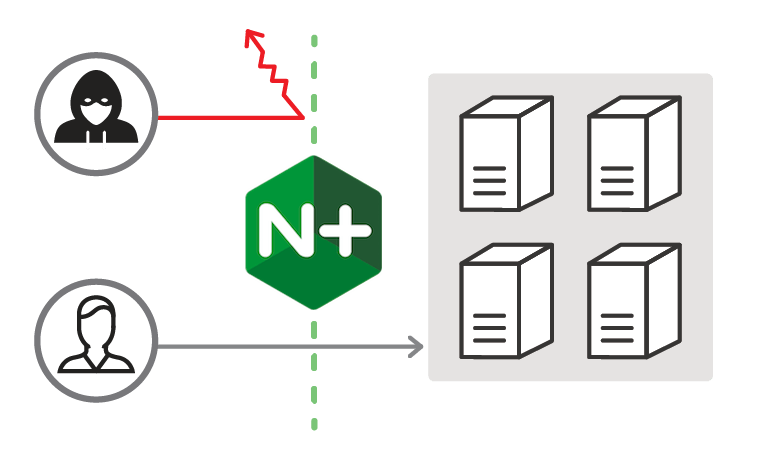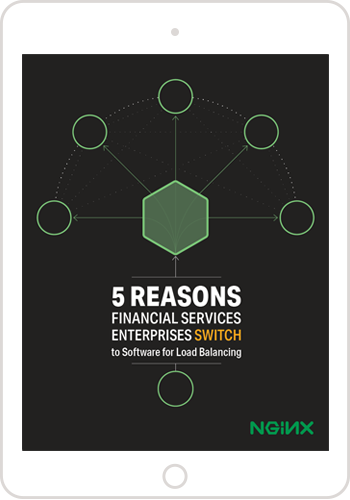Over the past year we’ve seen tremendous growth in NGINX Plus, from adding many new enterprise customers to our first‑ever inclusion in the Gartner Magic Quadrant. NGINX Plus extends NGINX Open Source with advanced functionality and award‑winning support, giving our customers a complete application delivery solution.
There a number of great reasons to move to NGINX Plus that we’ve highlighted this year, here on the NGINX blog. In this blog post we will highlight the three main categories of NGINX Plus advantages: cost savings, new features, and “evergreen” features.
1. Cost Savings
One of the most popular use cases for NGINX Plus is load balancing. In most enterprises today this is handled by hardware appliances such as the F5 BIG‑IP and Citrix NetScaler. Though these appliances have served enterprises well for 30 years, they are now limiting, in terms of features, flexibility, and functionality, and cost prohibitive.
Earlier this year we compared the price/performance of NGINX Plus to both the F5 BIG‑IP and Citrix NetScaler. We found that, with NGINX Plus, you can save over 80% while maintaining the same level of performance.
NGINX Plus also drives cost savings in many other use cases in addition to load balancing. You can contact NGINX for an evaluation of your specific situation.
2. New NGINX Plus Features
NGINX Plus has a number of great features that are not in NGINX Open Source. Though NGINX, Inc. commits the majority of its development resources to features that work in both versions, NGINX Plus always has some cutting‑edge or enterprise‑oriented features not found in NGINX Open Source, including advanced load balancing with session persistence, advanced cache control, active health checks, and live activity monitoring.
We are continuously improving NGINX Plus, with four releases in 2016 alone:
- NGINX Plus R8, January 2016 – Production‑ready HTTP/2, a persistent API for on‑the‑fly reconfiguration*, and scalable caching for large video files.
- NGINX Plus R9, April 2016 – Dynamic modules, UDP load balancing, and service discovery using DNS
SRVrecords*. Also: App pricing for NGINX Plus, an increasingly important capability for use with microservices. -
NGINX Plus R10, August 2016 – The fully supported NGINX ModSecurity WAF*, JSON Web Tokens (JWTs) for API authentication*, and “dual‑stack” support for both ECC and RSA security certificates, maximizing both security and web app performance.
[Editor – The NGINX ModSecurity WAF module for NGINX Plus officially went End-of-Sale as of April 1, 2022 and is transitioning to End-of-Life effective March 31, 2024. For more details, see F5 NGINX ModSecurity WAF Is Transitioning to End-of-Life on our blog.]
- NGINX Plus R11, October 2016 – Binary compatibility for dynamic modules, allowing third‑party NGINX modules to be easily used with NGINX Plus. Also: improvements to TCP/UDP load balancing, IP address geolocation, and enhancements to nginScript [Editor – Now called the NGINX JavaScript module].
* Feature exclusive to NGINX Plus

3. Evergreen Features Differentiate NGINX Plus
While new features get most of the attention, many reasons for considering NGINX Plus are “evergreen” – aspects that are integral to NGINX Plus, and will always distinguish NGINX Plus from NGINX Open Source.
These underlying reasons include:
- Release schedule. NGINX Plus is updated on a regular basis and tested extensively as a whole before release. This makes it easier for both NGINX, Inc. and customers to manage releases of NGINX Plus than NGINX Open Source.
- Support. NGINX Plus includes support from NGINX, Inc., including access to NGINX engineers. Many customers see this support and access as simply a necessity, given the foundational role that NGINX software plays within the software stack for tens of millions of websites.
- Certified modules. NGINX now supports dynamic modules, and NGINX Plus R11 introduced binary compatibility for them. Now, modules for NGINX Plus are certified against the latest NGINX Plus build. This makes NGINX Plus more flexible, and the combination of NGINX Plus and its modules more reliable.
Conclusion
All of these aspects of NGINX Plus make it an easy choice for high‑volume and mission critical web apps. As such, NGINX Plus is highlighted in a number of our recent, widely read case studies – Globo.com’s live video streaming; load balancing for Buydig.com’s ecommerce site, based on Microsoft’s .NET; and IgnitionOne’s ability to handle half a million requests per second for its media buying site.

Photo by Celso FLORES, licensed under the Creative Commons Attribution 2.0 Generic license.
No changes were made. Photo source: Wikimedia Commons.
A growing number of NGINX Open Source users and growing sites that have to scale reliably and securely are moving to NGINX Plus. To start experimenting with NGINX Plus yourself, download a free trial of NGINX Plus. To stay up to date with our new releases and more, sign up for the NGINX newsletter today.


